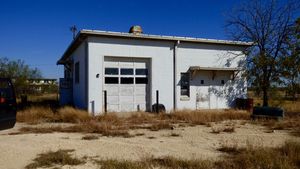Ozona Air Force Station
|
Ozona Air Force Station (1957-1963) - A Cold War Air Force Radar Station first established in 1957 near Ozona, Crockett County, Texas. Named Ozona Air Force Station after the location. Initially assigned a Permanent ID of TM-187. Abandoned in 1963.
History Established in 1957 and became operational in 1959 as Ozona Air Force Station manned by the 732nd AC&W Squadron. This station was one of eight stations established in the final phase of the Permanent AC&W Radar Program for the 33rd Air Division. The 33rd Air Division would remain a manual operation throughout the transition of the rest of the Air Defense System to the semi-automatic SAGE System. The Oklahoma City Manual Direction Center P-86 remained connected to these sites until they closed down one by one. Because the sites were never destined to become SAGE sites they received older less capable equipment and facilities and they were among the first to be closed when budgets constricted. The eight sites were:
The station initially had both a Ground-Control Intercept (GCI) and early warning mission. The early warning mission involved tracking and identifying all aircraft entering their airspace while the GCI mission involved guiding Air Force interceptors to any identified enemy aircraft. Controllers at the station vectored fighter aircraft at the correct course and speed to intercept enemy aircraft using voice commands via ground-to-air radio. Initial equipment included the FPS-3 search radar and an FPS-6 height-finder radar.
Gap FillersOzona AFS was responsible for the maintenance of two remote unattended gap-filler radar sites. The unattended gap filler sites were placed in locations where the main search radar lacked coverage. These sites were equipped with short range FPS-14 or FPS-18 search radars and FST-1 Coordinate Data transmitters that sent digitized radar target data to a SAGE direction center and to the main radar site. Both the radar set and the FST-1 were dual channel to increase site up time. Maintenance teams were dispatched for regularly scheduled maintenance or when fault indicators on the FSW-1 remote monitoring equipment suggested the site had problems. The FSW-1 also allowed remote operation of specific functions such as channel changes for the radar and for the FST-1, it also allowed remote operation of the diesel generators at the gap filler site. The Ozona AFS gap-filler radars were located at McCamey and Comstock, Texas.
ClosureOzona AFS and the 732nd were deactivated on 1 Aug 1963. The equipment was removed and the property was sold at public auction by the GSA in January 1965. Physical Plant The physical plant of the site was divided into the main site, a cantonment area, a housing area and a radio site. The main site housed the operations buildings, the radar towers, and the backup generators. The cantonment area housed the enlisted barracks, the bachelor officer's quarters, the orderly room, the dining hall, the motor pool and other support buildings. Apart from the main site was a small 27 unit housing area for married personnel. A separate Ground to Air Transmitter/Receiver (GATR) radio site housed the radio equipment for directing aircraft intercepts.
Current StatusThe operations area buildings were demolished circa 2005 and replaced with industrial buildings. The front portion of the cantonment area is in private hands and access is restricted. The rear portion of the cantonment area (including the barracks, dining hall, supply, rec hall and radio site) is owned by the Boy Scouts of America but is unoccupied and deteriorating. The housing area is in private hands and is now known as Crockett Heights.
See Also: Sources:
Visited: 26 Nov 2017
| ||||||||||||||||||||||||||||||||||||||||||||||||||||||


